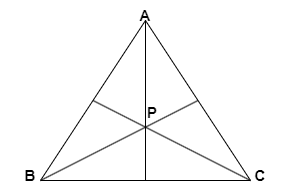
If $P$ is any point within a $\Delta ABC$ , then $PA + CP$ is equal to
A. $AC + CB$
B. $BC + BA$
C. $CB + AB$
D. $CB + BA$
Answer
216.3k+ views
Hint: A triangle is a closed figure in a plane consisting of three segments called sides. Any two sides intersect at exactly one point called a vertex. A triangle can be classified according to its sides, angles or combination of both. Based on sides, we have: Equilateral triangle, Isosceles triangle and Scalene triangle having all three sides congruent, two sides congruent and no sides congruent respectively.
Complete step by step solution:
We are given a $\Delta ABC$ with vertices $A$ , $B$ and $C$ .

Image: Triangle ABC
Let two angle bisectors from vertex $A$ and $C$ , intersect at point $P$ .
Such that,
$CP + PA = CA$
Now using the property of the triangles, we have, “The Sum of lengths of two sides of a triangle $ \geqslant $ The length of the third side”. Here, we are considering it as equal.
We can write side $CA$ as the sum of other two sides, i.e.,
$CA = CB + BA$
Now, substituting the value of $CA$ in the above equation, we get
$CP + PA = CB + BA$
Hence, the correct option is D.
Note: All equilateral triangles are also isosceles triangles since every equilateral triangle has at least two of its sides congruent. Some isosceles triangles can be equilateral if all three sides are congruent. An angle bisector of a triangle is the segment that bisects an angle of a triangle. Every triangle has three angle bisectors.
Complete step by step solution:
We are given a $\Delta ABC$ with vertices $A$ , $B$ and $C$ .

Image: Triangle ABC
Let two angle bisectors from vertex $A$ and $C$ , intersect at point $P$ .
Such that,
$CP + PA = CA$
Now using the property of the triangles, we have, “The Sum of lengths of two sides of a triangle $ \geqslant $ The length of the third side”. Here, we are considering it as equal.
We can write side $CA$ as the sum of other two sides, i.e.,
$CA = CB + BA$
Now, substituting the value of $CA$ in the above equation, we get
$CP + PA = CB + BA$
Hence, the correct option is D.
Note: All equilateral triangles are also isosceles triangles since every equilateral triangle has at least two of its sides congruent. Some isosceles triangles can be equilateral if all three sides are congruent. An angle bisector of a triangle is the segment that bisects an angle of a triangle. Every triangle has three angle bisectors.
Recently Updated Pages
JEE Main 2024 (January 24 Shift 1) Question Paper with Solutions [PDF]

Progressive Wave: Meaning, Types & Examples Explained

Temperature Dependence of Resistivity Explained

JEE Main 2024 (January 25 Shift 1) Physics Question Paper with Solutions [PDF]

Difference Between Vectors and Scalars: JEE Main 2026

Salt Hydrolysis IIT JEE | Aсіdіtу and Alkаlіnіtу of Sаlt Sоlutіоns JEE Chemistry

Trending doubts
JEE Main 2026: Application Form Open, Exam Dates, Syllabus, Eligibility & Question Papers

JEE Main 2026 Chapter-Wise Syllabus for Physics, Chemistry and Maths – Download PDF

JEE Main Previous Year Question Paper with Answer Keys and Solutions

Understanding Newton’s Laws of Motion

JEE Main Cut Off 2026 - Expected Qualifying Marks and Percentile Category Wise

Marks vs Percentile JEE Mains 2026: Calculate Percentile Marks

Other Pages
NCERT Solutions For Class 10 Maths Chapter 12 Surface Area And Volume

NCERT Solutions for Class 10 Maths Chapter Chapter 13 Statistics

NCERT Solutions for Class 10 Maths Chapter 11 Areas Related to Circles 2025-26

Pregnancy Week and Due Date Calculator: Find How Far Along You Are

NCERT Solutions for Class 10 Maths Chapter 15 Probability

Complete List of Class 10 Maths Formulas (Chapterwise)




